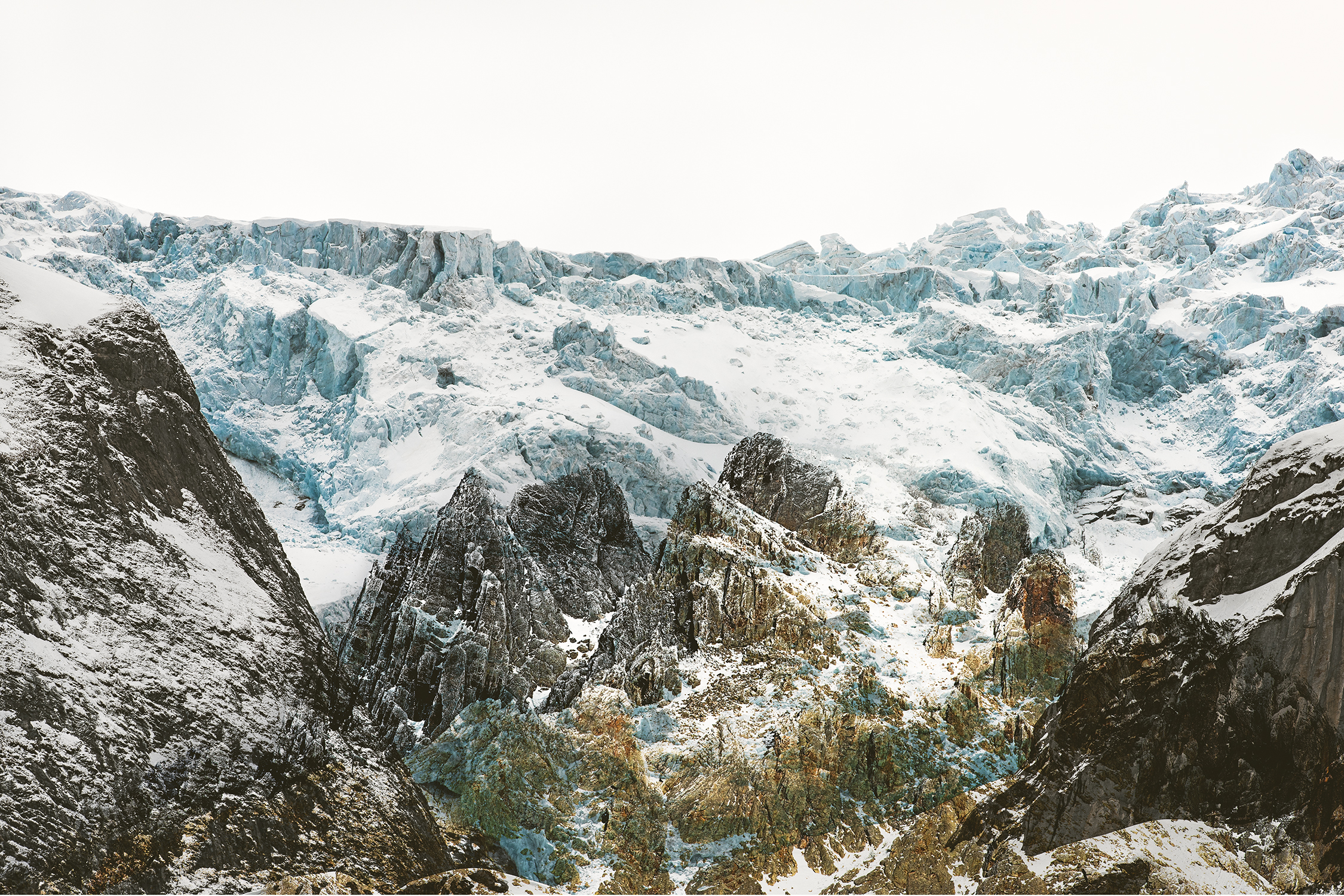
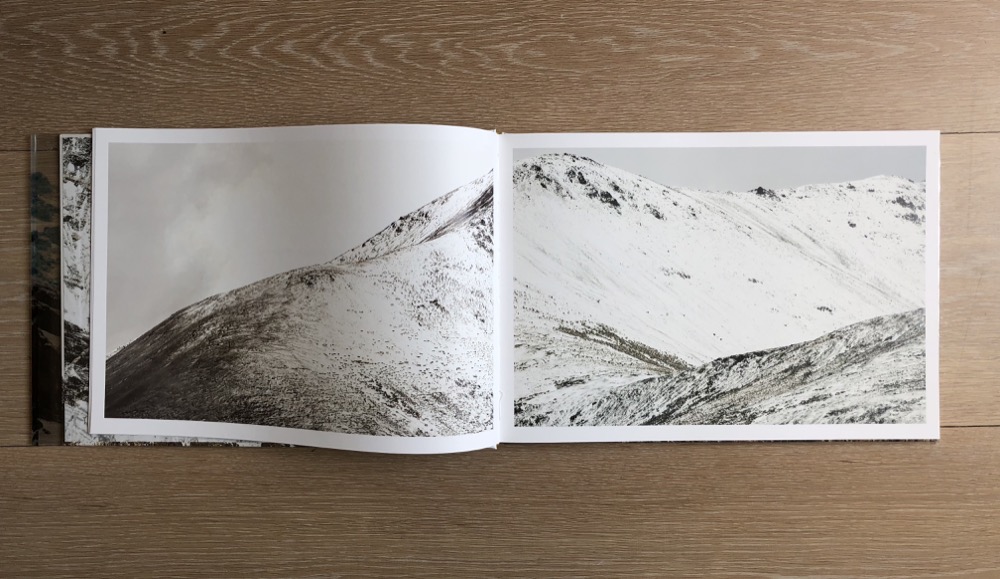
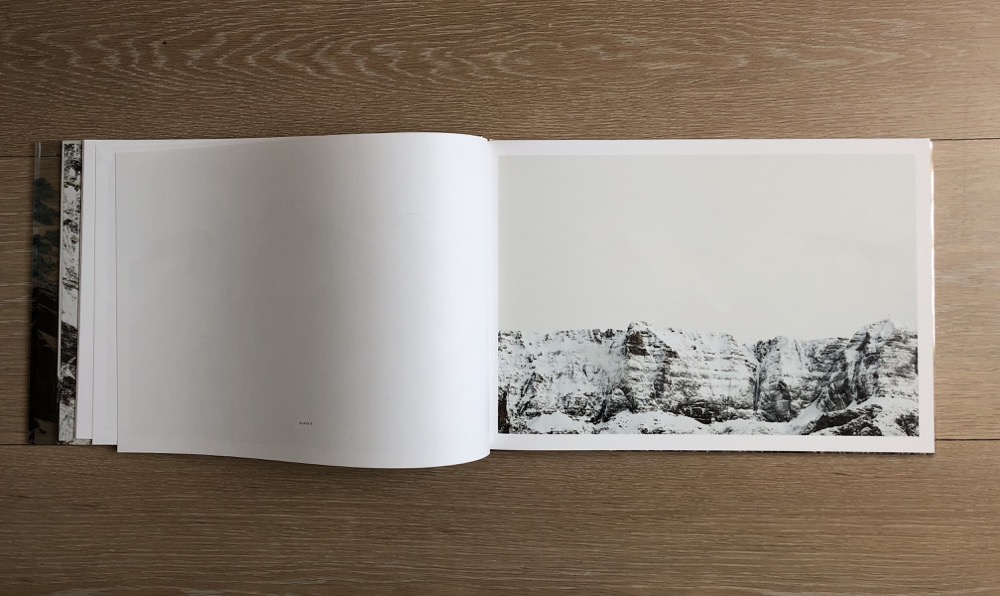
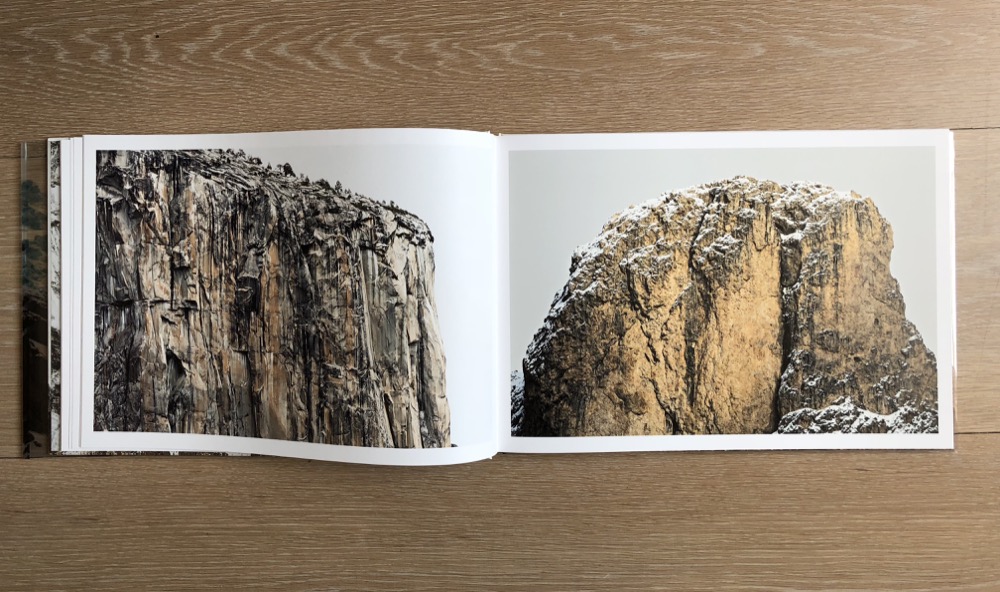
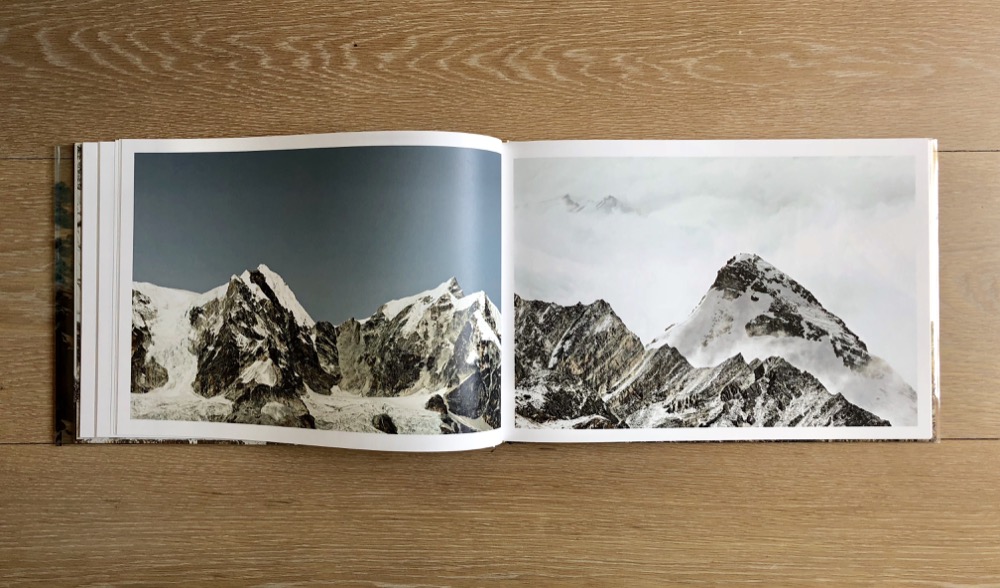
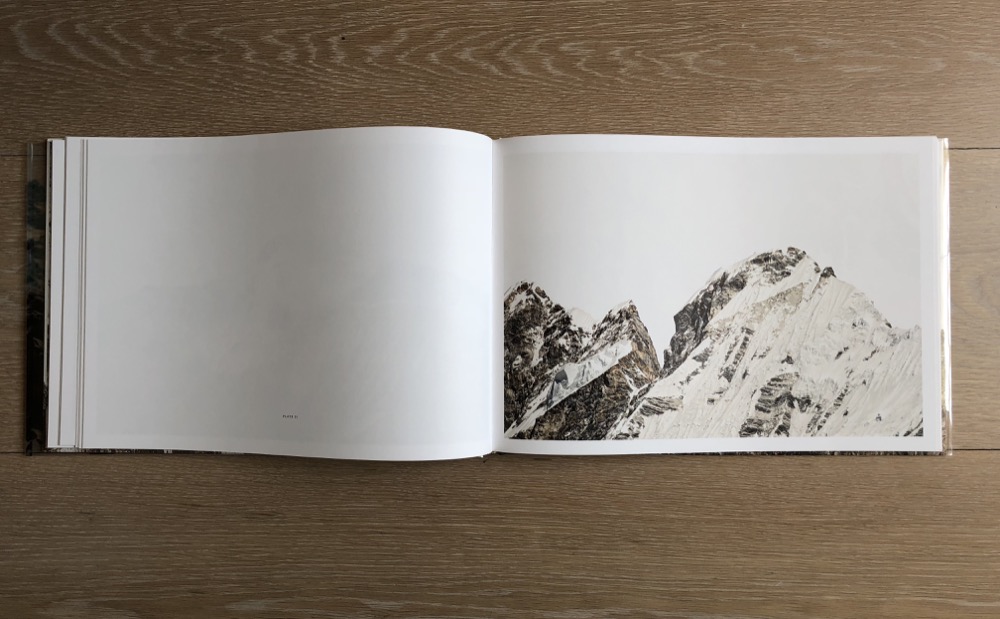
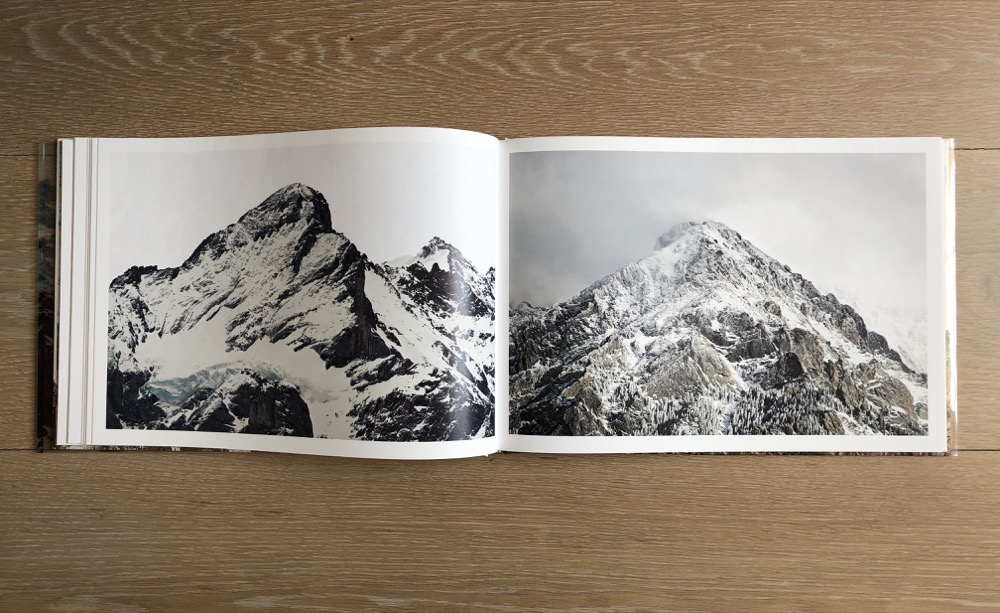



Photography by Renate Aller
Essay by Terrie Sultan
Published by Radius Books
Links to order book:
Publisher, Radius Books
Distributor, Artbook DAP
Publication date: June 2018
- Hardcover with acetate jacket
- 14.25 x 10.25 inches
- 64 color images / 124 pages
- Photography by Renate Aller
- Essay by Terrie Sultan
- ISBN: 9781942185383
- Trade Edition – $60
About The Book
The latest project from New York–based photographer Renate Aller includes mountain peaks from six continents.These photographs were taken from locations as high as 22,500 feet (adjacent to Mount Everest) to the European glaciers and mountain peaks of her childhood vacations. The subject matter is monumental, yet the images connect the viewer in a way that is not overpowering. Similar to the sand dune images from Ocean | Desert (Radius, 2014), the artist engages us with these giants in all their detail, the veins and textures of the rocks in their constantly transient state. Aller isolates the mountain from its expected surroundings, using and presenting the familiar and the known in an intimate way, relating to parallel realities from different locations, opening up conversations between the different (political) landscapes in which we live.
About The Artist
Born in Germany, Renate Aller lives and works in New York. Mountain Interval is her fourth is her fourth monograph published with Radius Books, following Ocean | Desert, dicotyledon, and the long-term project Oceanscapes. Her artworks are in the collections of corporate institutions, private collectors, and museums, including Lannan Foundation, Santa Fe; National Gallery of Art, Washington, DC; Yale University Art Gallery, New Haven, CT; George Eastman House, Rochester, NY; New Britain Museum of American Art, CT; Hamburger Kunsthalle, Germany; Chazen Museum of Art, Madison, WI; and Parrish Art Museum, Water Mill, NY.
About The Author
Terrie Sultan is an American art historian and museum director. She is the director of the Parrish Art Museum in Long Island, New York. Her previous position was at the University of Houston in Texas. She has served in senior positions at the New Museum of Contemporary Art in New York, the Corcoran Gallery of Art in Washington, DC, and the Blaffer Art Museum at the University of Houston. Sultan is a member of the International Association of Art Critics; is a Founding board member of Étant donnés, the French-American Endowment for Contemporary Art; and was awarded a Chevalier in the Ordre des Arts et des Lettres by the Government of France (2003). Under her direction, the Parrish Art Museum constructed a new campus in Water Mill, New York.
MEMORY, EXPECTATION, AND THE MYSTERY OF SCALE
TERRIE SULTAN
We want the world because it is beautiful, its sounds and smells and textures, the sensate presence of the world as body.
James Hillman[1]
Renate Aller’s dynamic compositions are rich with implied narratives, and the photo- graphs in her Mountain Interval series are the fullest expression of her exploration of the interrelationships of romanticism, memory, and place. Capturing the most celebrated and challenging mountain ranges across six continents, photographing while standing at elevations as high as 22,500 feet, her pictures present vistas that are forbidding yet strangely intimate, and never exactly what they seem at first glance.
Aller’s mountainscapes are generally displaced from contextualizing surroundings or perceptible human interaction. Each image acts as an individual portrait of rock and snow, at once familiar and enigmatic in its singularity. Certain of the places we see in her photographs don’t exist, however: these hybrid places are Aller’s own invention, separate mountain ranges layered one on top of the other by the artist to create an aesthetically compelling whole. Works like #1 – USA, Colorado, Rocky Mountains, Nov. 2015 | Swiss Alps, March 201 (plate 59) are identified only through the title notations of place. They present a new reality, a sort of deeply felt postcard from the artist’s imagination. One could say that Aller landscapes her perceptions—and ours—just as a gardener might arrange and juxtapose disparate elements in the service of a harmonious experience. In this context the word landscape functions also as a verb, describing actions taken for aesthetic improvement. Whether composed or straightforwardly recorded, Aller’s photographs convey a sense of transcendent grandeur that is inherent to the natural world. Calling attention to the importance of experiencing and perceiving nature, her work embodies the cultural historian Simon Schama’s observation that “there is a difference between land, which is earth, and landscape, which signifies a kind of jurisdiction. It always meant the framing of an image.” The word landscape, Schama continues, “originally came from the Dutch and had to do with making pictures. From the earliest time, it has been loaded with wishful thinking. All the images we have of Yosemite are of Edenic places. You never see people in Ansel Adams photographs or Albert Bierstadt paintings.”[2]
In painting, drawing, or photography, a landscape depicts a particular place. The word can also refer to a situation, such as a social or economic circumstance, or to an emotional or psychological state of being—all aspects that play a role in Aller’s approach to her photographs. In his book Landscape and Memory, Schama contrasts the physicality of the land with the idealized landscape images central to Western culture and examines how the primeval forests of Germany and the American West illuminated legends that shaped elemental social characteristics.[3] Aller, who was born in Hamburg, spent her childhood vacations hiking and photographing in the mountains of Austria, Germany, and Italy, locations recalling the Romantic paintings of Caspar David Friedrich (1774–1840). Friedrich’s works epitomized an aesthetic that sought to integrate art, science, and philosophy to communicate an ideal of transcendence. While Aller feels a deep connection with this sensibility, what makes her images singular is the sense of displacement they achieve. Instead of transcendence, her scenes are redolent with silent anticipation. In fact, she says, “I’ve always been fascinated by the space between memory and expectation. I used to compose music, and the notion of the interval—really the silence between notes—became for me a way to think about what exists in the world that is unseen and unheard, but that exists. This is why I call this series Mountain Interval. The mountains are an extension of all the work that came before. There is a relationship between the ongoing Oceanscapes project begun in 1999, and the desert pictures I have made over time and the more recent mountain pictures.”[4] In the book Ocean| Desert (2014), for example, she juxtaposes images of the ocean near her home on the South Fork of Long Island with those of vast expanses of sand dunes in New Mexico and Colorado. For Aller, two disparate locales are intimately connected. In Mountain Interval she moves away from horizontal planes of ocean and sand while retaining the sensibility of calm intensity of those earlier works.
The way we look at nature from a distance is similar to the way painters of the Romantic period presented their work to the viewer. While our human desire is to tame nature, and our relationship to it is one of intervention and domination, our ambivalence with nature is reflected in the way we look at it. We use the landscape image as a mirror of ourselves—filled with illusions, desire, and nostalgia—and as a fulfillment of our idealized self. We expect nature to present itself as a stage set for our entertainment.
—Renate Aller [5]
Throughout American history, landscape imagery has defined an expansive nation-al identity relating to exploration, exploitation, and reclamation, in terms of both natural resources and political power. The primary goal of Meriwether Lewis and William Clark’s Corps of Discovery expedition, a two-year research and mapping project commissioned by Thomas Jefferson after the Louisiana Purchase of 1803, was to claim the newly acquired territories, assess and inventory their features, and establish trade ties with the Native American peoples who lived in them. By the late 1800s, artists such as Albert Bierstadt (1830–1902) and Thomas Moran (1837–1926) were touring the western territories, and sketching and producing painted studies. Upon returning to their studios, they painted monumentally scaled, often idealized canvases that celebrated the nation’s westward expansion. Other artists, including Frederic Church (1826–1900) and Martin Johnson Heade (1819–1904), made worldwide peregrinations in search of unique, rarely seen vistas. Church’s Heart of the Andes afforded a sensational rendering of a remote South American mountain range. Presented as a coherent observational record, the painting is in fact a composite of several types of topographies Church saw and recorded in his travels throughout South America. Works like this, conveying distant terrains in extreme scale and detail, are clearly antecedents of Aller’s Mountain Interval photographs.
Siting nineteenth-century aesthetic values in the wilderness was not limited to painting. Eadweard Muybridge (1830–1904) and Carleton Watkins (1829–1916) employed the recently invented medium of glass-plate photography to record the Yosemite Valley and other remote western territories. Muybridge and Watkins gradually departed from the Romanticism prevalent in the work of eastern painters—notably those associated with the Hudson River School—in favor of an environment “sublimely unpeopled, with huge vistas under open skies. . . . The sublime invited the viewer to gape in awe at the vista, often seen from above.”[6] The same subjects were revisited and recontextualized by twentieth-century photographers such as Ansel Adams (1902–1984), who exaggerated tonal contrasts to intensify or distill drama in his images of Yosemite National Park.
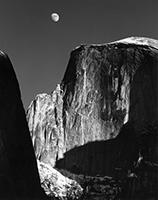
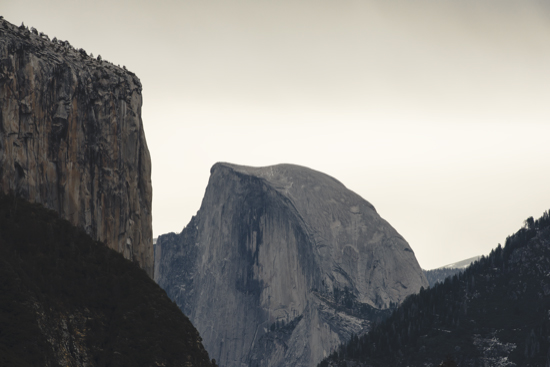
LEFT: Moon and Half Dome, Yosemite National Park, California, 1960. Photograph by Ansel Adams.
RIGHT: #109 s – USA, California, Yosemite, Dec. 2017. Photograph by Renate Aller.
A compare-and-contrast between Adams’s Moon and Half Dome, Yosemite National Park, California (1960) and Aller’s #109 s – USA, California, Yosemite, Dec. 2017 (plate 59) shows how two distinct yet philosophically related approaches can result in dramatically diverse expressions of the same subject. Adams’s vertical portrait orientation of Half Dome is moody and theatrical, with the overhanging moon acting as a far-off character in the pictorial composition. Aller’s horizontal format places the dome centrally, but at a greater distance, contextualized by the surrounding hills and crags.
In his comprehensive American Photography, the art historian Miles Orvell proposes three main types of landscape photographs, “according to their respective purposes: the view, which renders the scene itself as a spectacle of wonder; the aesthetic landscape, where the photographer’s artistic vision animates the image; and the topographic photograph, where the image is more descriptive and is part of a larger political or scientific discourse.”[7] Traveling widely, locating her images across Europe, Asia, Oceania, and the Americas, Aller embraces all three categories. She approaches making her photographs as if they were portraits, not only of place and time but also of emotional and psychological attachment. Peering through the high-definition digital 400mm fixed lens of her camera, she can “grab the texture of these giant granite blocks—and later, when viewing the images on my screen and as test prints, it feels as if I can touch them; they become very tactile.” Further, she says:
Humans’ relationship to scale fascinates me. When we walk through a forest, or in the mountains, or even in the city, it’s difficult to gauge distances and relative scale. In using a digital camera, I can bring things from the far distance into a sharp focus that interferes, in some way, with how we understand where we are in the world.
It is a truism of our era that the boundary between the natural and man-made worlds has blurred beyond utility.
— Nancy Princenthal [8]
When I think of Art, I think of beauty. Beauty is the mystery of life. It is not in the eye, it is in the mind. In our minds there is awareness of perfection.
— Agnes Martin [9]
In the Mountain Interval series, Aller subtly informs us about her process by noting place and date, adding the designation “s” to signify factual, unaltered images, as opposed to the composites that she creates digitally with overlapping images of different locales. When we look at #12 s Swiss Alps 2 April, 2016 (plate 41) alongside #6 – Italy, Dolomites, Nov. 2016 | New Zealand, The Remarkables, Dec. 2016 (plate 27) it is difficult to tell the difference, which is entirely the artist’s point. As she explains: “In this picture of the Swiss Alps, there is a beautiful rising of cloud, fog. Sometimes the combinations look like the same place, while a single shot can look like combinations. It is really about impression as much as it is about geography.”
Aller has carefully crafted the sequence of images in this book, producing narratives through contrasts and harmony. One striking link is between #85s – Alaska, Matanuska Range, Aug. 2017 (plate 30), pictured on the left, and #68s – Nepal, Himalayas, Everest Region, Dec. 2016 (plate 31), shown on the right. Of this visual narrative, the artist says:
I like the compare-and-contrast of these two images. They are worlds away from each other in location, but have so much in common. Although they have a different history, have a different origin, are made from different materials, and spiritually have a different energy, I think that they are actually telling me the same story.
Ultimately, Renate Aller has a story to tell about our changing relationship with the world in which we live. This story has been cast with the hourly changes in the personality of the Atlantic Ocean as viewed from a single point on the eastern Long Island coast; with the organic undulations of sand dunes in New Mexico and Colorado; and, as in Mountain Interval, with the massive, seemingly immovable mountains that remain among the last wild places in the world.
ENDNOTES
[1] James Hillman, “The Practice of Beauty,” in Uncontrollable Beauty: Toward a New Aesthetics, ed. Bill Beckley with David Shapiro (New York: Allworth Press, 1998), p. 264.
[2] Mel Gussow, “Into Arcadia with Simon Schama,” The New York Times, June 5, 1995, http://www. nytimes.com/1995/06/05/books/into-arcadia-with-simon-schama.html.
[3] Simon Schama, Landscape and Memory (New York: Vintage, 1995).
[4] All quotations of Renate Aller, unless otherwise noted, are from an interview with the author conducted in the artist’s New York City studio, October 25, 2017.
[5] Renate Aller, artist’s statement, www.renatealler.com.
[6] Miles Orvell, American Photography (Oxford and New York: Oxford University Press, 2003), p. 43.
[7] Ibid., p. 41.
[8] Nancy Princenthal, “The Ghost’s Machine,” in Landscape Reclaimed: New Approaches to an Artistic Tradition (Ridgefield, CT: Aldrich Museum of Contemporary Art, 1996), p. 13.
[9] Agnes Martin, “Beauty Is the Mystery of Life,” in Uncontrollable Beauty: Toward a New Aesthetics, ed. Bill Beckley with David Shapiro (New York: Allworth Press, 1998), p. 199.
TERRIE SULTAN has guided the Parrish Art Museum as director since 2008.
She has more than 28 years of experience as a museum professional, having served in senior positions at the New Museum of Contemporary Art, the Corcoran Gallery of Art, and the Blaffer Museum at the University of Houston. She has organized more than 45 exhibitions in her career, including Julião Sarmento: Artists and Writers/House and Home, Chantal Akerman: Moving through Time and Space, Jessica Stockholder: Kissing the Wall, and Chuck Close: Prints, Process, and Collaboration. An accomplished writer, she has authored or contributed to dozens of publications, including Jennifer Bartlett: History
of the Universe (2013), Alice Aycock: Some Stories Are Worth Repeating (2013), Damaged Romanticism: A Mirror of Modern Emotion (2008), Jean-Luc Mylayne (2007), and Kerry James Marshall (2000). Sultan is a member of the International Association of Art Critics; served on the College Art Association’s award committee for Lifetime Achievement for Art Writing; and was a founding board member of Étant donnés, the French-American Endowment for Contemporary Art. In 2003 she was awarded a Chevalier de l’Ordre des Arts et Lettres by the Government of France.
Born in Germany, RENATE ALLER lives and works in New York. Mountain Interval is her fourth monograph published with Radius Books, following Ocean | Desert (2014), dicotyledon (2012), and the long-term project Oceanscapes – One View – Ten Years (2010). Together, the four series represent the artist’s investigation into the relationship between Romanticism, memory, and landscape in the context of our current sociopolitical awareness. Aller’s artworks are in corporate and private collections, as well as museums, including Lannan Foundation, National Gallery of Art, Yale University Art Gallery, George East-man Museum, New Britain Museum of American Art, Hamburger Kunsthalle, Chazen Museum of Art, and Parrish Art Museum.
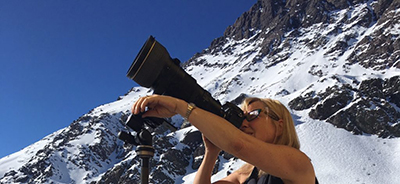
The mountain peaks in Mountain Interval are familiar and at the same time appear to be abstract. To engage with these images is to enter a non-quantifiable space — a disembodiment due to the loss of sense of scale, a disruption of the equation between your body and what you experience.
This interval, the space in between, is about the moments during which apparently nothing happens, but without which no change could happen. This state of stillness and transition is a space between memory and expectation.
RENATE ALLER